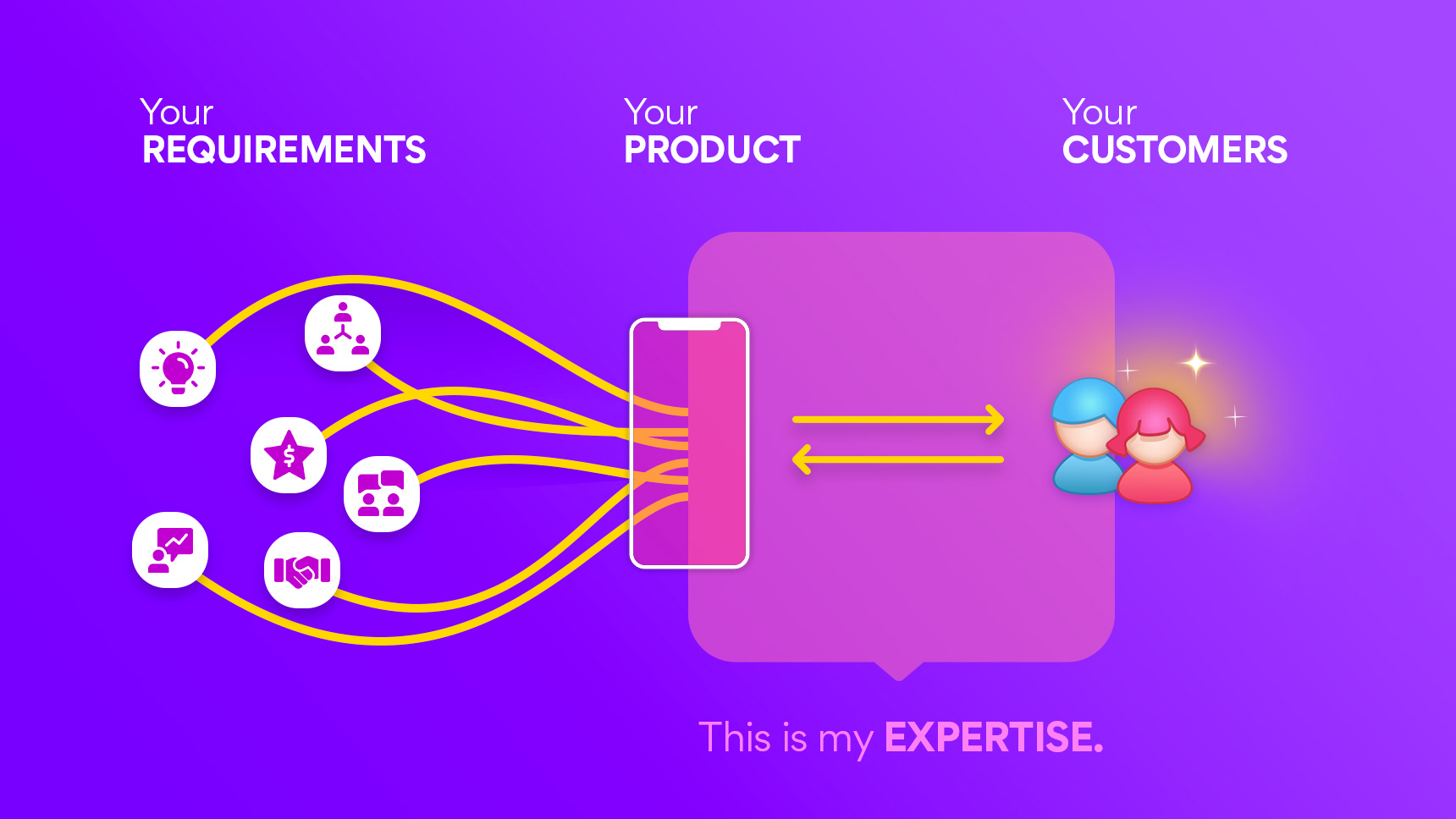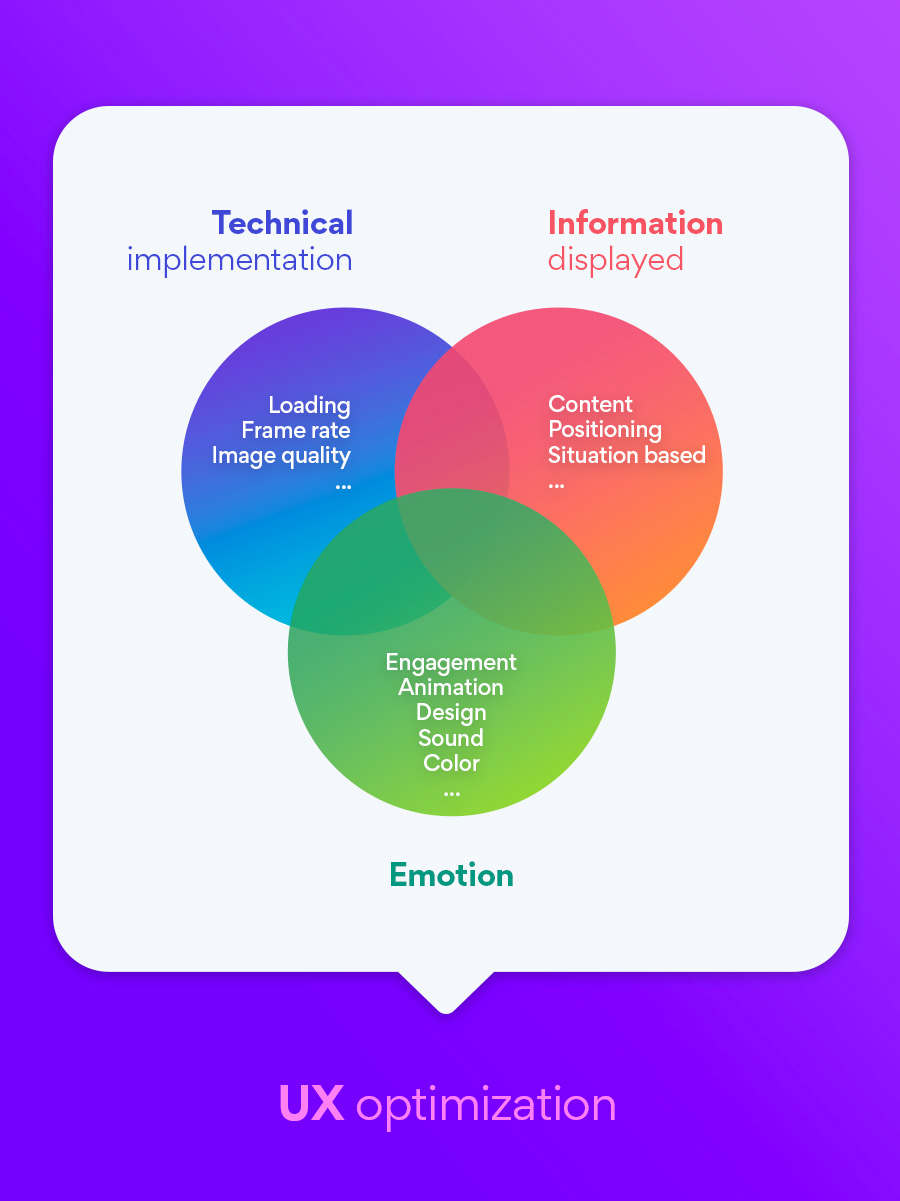I translate business requirements into customer language.

Products can be very complex; especially when there are so many useful features to show off. The trick is to present the user with the right feature at the right time. The product should be one step ahead and ready to help when it's needed. This approach leads to positive experiences and ultimately gratification. And that’s what it’s all about: GRATIFICATION.
First we focus on the best solution possible and after on the technical feasibility. The experience I made: if it is great it can be done. And if not it is better to reduce features from the perfect version rather than from a good version. Let's think big and implement step by step. Once you know the best - and most likely most time consuming - version you can easily cut features into small parts. This saves time and money.
No matter whether we work on an existing product or a new product, we'll check the user experience in three areas: the technical implementation, the information displayed on the screens and the emotions awakened while using the product.
First we focus on the best solution possible and after on the technical feasibility. The experience I made: if it is great it can be done. And if not it is better to reduce features from the perfect version rather than from a good version. Let's think big and implement step by step. Once you know the best - and most likely most time consuming - version you can easily cut features into small parts. This saves time and money.
No matter whether we work on an existing product or a new product, we'll check the user experience in three areas: the technical implementation, the information displayed on the screens and the emotions awakened while using the product.

Technical implementation
Customers don't have much time and that's why a perfect implementation is very important. Loading time, frame rate, image quality and errors are just a few examples for what could counteract a smooth interaction.
Information displayed
Same here: customers don't have much time. Less reading can make users find what they are looking for faster. Here we should focus on what show, when and where to show. Displaying the information at the right moment is key.
Emotion
How does it feel using the product. Is it visually exciting, easy to use, and emotionally engaging? Is there anything that bothers me? What makes me stay, what makes me come back? Am I excited using the product because I know I'm not wasting my time and I get what I want right away? The more we put into the role of a user the better we can serve them.
I have a proven track record solving complex interaction problems across multiple platforms. In weekly updates I successfully implemented and optimized features for more than 2 million users. With my eye for pixel perfect detail, I possess a strong blend of interaction and visual design skills, as well as user-centered design principals. My affinity for consistency, color use, typography, and a keen eye for subtle details helps me create products that are fun to experience.
Let's create a brand fitting, engaging, fun and easy to use product with an increase of user numbers, retention and revenues.
Happy User
Gratification makes the user happy, and a happy user will advocate for your product. They will gladly tell friends, family and peers about their experience making them your biggest asset.
Make users stay
Acquiring users is time consuming and can be costly. This is precisely why its so important to keep users. You want them to spend time with your product. The more time they spend the more they are engaged and the more likely it is that they will eventually spend. There are many psychological tricks I learned from creating games that can be applied to almost any product. Hooks that make users come back again, and again. And again.
Make users pay
Product development and user acquisition can require a significant investment. That's why we need users who are willing to spend. This can spend on something they really need or just something they really want - which we monetized in our games. In both cases positive emotion is key. Users who are highly engaged are easier to monetize. A paying user is more likely to stay with your product as they develop a deeper personal connection to the product.
Gamification
Does implementing a game into a boring task makes the task fun? Is this gamification? The short answer is No. This statement on its own puts such a compelling tool into the wrong light. Gamification is extremely powerful, and sometimes manipulative. We can entice users do things they wouldn’t normally consider and they will do it with ease. How can we achieve this? It's not easy but if you combine psychological elements from gaming with the task to be done, it can be accomplished, even before the user realizes the time spent on it. Gamification is a fantastic tool - if it's done right.
Responsibility
How do we create great products? By being responsible. That is what I believe. And that is what I always communicate to my team. Accept the responsibility of creating products with the goal to have users spend time with them. It's a privilege to have users spend their valuable time within our products and we should strive to create products that respect the users time.
One of our games was played by 1.6 million people every day. Every bug has a huge impact, also every feature. Feeling responsible makes it easy to go the extra mile. That's what we owe the users.
One of our games was played by 1.6 million people every day. Every bug has a huge impact, also every feature. Feeling responsible makes it easy to go the extra mile. That's what we owe the users.
That's me

© 2021 Meisterstudios